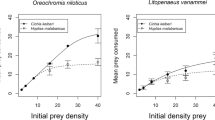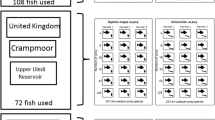Abstract
Forecasting the ecological impacts of invasive species is a major challenge that has seen little progress, yet the development of robust predictive approaches is essential as new invasion threats continue to emerge. A common feature of ecologically damaging invaders is their ability to rapidly exploit and deplete resources. We thus hypothesized that the ‘functional response’ (the relationship between resource density and consumption rate) of such invasive species might be of consistently greater magnitude than those of taxonomically and/or trophically similar native species. Here, we derived functional responses of the predatory Ponto-Caspian freshwater ‘bloody red’ shrimp, Hemimysis anomala, a recent and ecologically damaging invader in Europe and N. America, in comparison to the local native analogues Mysis salemaai and Mysis diluviana in Ireland and Canada, respectively. This was conducted in a novel set of experiments involving multiple prey species in each geographic location and a prey species that occurs in both regions. The predatory functional responses of the invader were generally higher than those of the comparator native species and this difference was consistent across invaded regions. Moreover, those prey species characterized by the strongest and potentially de-stabilizing Type II functional responses in our laboratory experiments were the same prey species found to be most impacted by H. anomala in the field. The impact potential of H. anomala was further indicated when it exhibited similar or higher attack rates, consistently lower prey handling times and higher maximum feeding rates compared to those of the two Mysis species, formerly known as ‘Mysis relicta’, which itself has an extensive history of foodweb disruption in lakes to which it has been introduced. Comparative functional responses thus merit further exploration as a methodology for predicting severe community-level impacts of current and future invasive species and could be entered into risk assessment protocols.

Similar content being viewed by others
References
Akre BG, Johnson DM (1979) Switching and sigmoid functional response curves by damselfly naiads with alternative prey available. J Anim Ecol 48:703–720
Alexander ME, Dick JTA, O’Connor N, Haddaway N, Farnsworth KD (2012) Functional responses of the intertidal amphipod Echinogammarus marinus: effects of prey supply, model selection and habitat complexity. Mar Ecol Prog Ser (in press)
Andersen MC, Adams H, Hope B, Powell M (2004) Risk analysis for invasive species: general framework and research needs. Risk Anal 24:893–900
Bolker BM (2010) Emdbook: ecological models and data in R. R PackageVersion 121
Bollache L, Dick JTA, Farnsworth KD, Montgomery WI (2008) Comparison of the functional responses of invasive and native amphipods. Biol Lett 4:166–169
Borcherding J, Murawski S, Arndt H (2006) Population ecology, vertical migration and feeding of the Ponto-Caspian invader Hemimysis anomala in a gravel-pit lake connected to the River Rhine. Freshwat Biol 51:2376–2387
Byers JE, Reichard S, Randall JM, Parker IM, Smith CS, Lonsdale WM et al (2002) Directing research to reduce the impacts of nonindigenous species. Conserv Biol 16:630–640
Caldow RW, Furness RW (2001) Does Holling’s disc equation explain the functional response of a kleptoparasite? J Anim Ecol 70:650–662
Colautti RI, MacIsaac HJ (2004) A neutral terminology to define ‘invasive’ species. Divers Distrib 10:135–141
Colbourne JK, Crease TJ, Weider LJ, Hebert PDN, Dufresne F, Hobæk A (1998) Phylogenetics and evolution of a circumarctic species complex (Cladocera: Daphnia pulex). Biol J Linn Soc 65:347–365
Cronk QCB, Fuller JL (1995) Plant invaders, 1st edn. Chapman & Hall, London
Davis MA (2009) Invasion biology, 1st edn. Oxford University Press, Oxford
Dick JTA, Armstrong M, Clarke HC, Farnsworth KD, Hatcher MJ, Ennis M, Kelly A, Dunn AM (2010) Parasitism may enhance rather than reduce the predatory impact of an invader. Biol Lett 6:636–638
Farnsworth KD, Focardi S, Beecham JA (2002) Grassland-herbivore interactions: how do grazers coexist? Am Nat 159:24–39
Funk JL, Vitousek PM (2007) Resource-use efficiency and plant invasion in low resource systems. Nature 446:1079–1081
Haddaway NR, Wilcox RH, Heptonstall REA, Griffiths HM, Mortimer RJG, Christmas M, Dunn AM (2012) Predatory functional response and prey choice identify predation differences between native/invasive and parasitised/unparasitised crayfish. PLoS ONE 7(2):e32229
Hayes KR, Barry SC (2008) Are there any consistent predictors of invasion success? Biol Inv 10:483–506
Holdich D, Gallagher S, Rippon L, Harding P, Stubbington R (2006) The invasive Ponto-Caspian mysid, Hemimysis anomala, reaches the UK. Aq Inv 1:4–6
Holling CS (1959) Some characteristics of simple types of predation and parasitism. Can Entomol 91:385–398
Hoof RC, Bollens SM (2004) Functional response and potential predatory impact of Tortanus dextrilobatus, a carnivorous copepod recently introduced to the San Francisco Estuary. Mar Ecol Prog Ser 277:167–179
Jeschke JM, Hohberg K (2008) Predicting and testing functional responses: an example from a tardigrade-nematode system. Bas App Ecol 9:145–151
Jeschke JM, Kopp M, Tollrian R (2002) Predator functional responses: discriminating between handling and digesting prey. Ecol Monog 72:95–112
Johnson BM, Martinez PJ, Hawkins JA, Bestgen KR (2008) Ranking predatory threats by nonnative fishes in the Yampa River, Colorado via bioenergetics modeling. N Am J Fish Man 28:1941–1953
Jones DB, Giles KL, Berberet RC, Royer TA, Elliot NC, Payton ME (2003) Functional responses of an introduced parasitoid and an indigenous parasitoid on greenbug at four temperatures. Environ Entomol 32:425–432
Jones C, Pech R, Forrester G, King CM, Murphy EC (2011) Functional responses of an invasive top predator Mustela erminea to invasive meso-predators Rattus rattus and Mus musculus, in New Zealand forests. Wildl Res 38:131–140
Juliano SA (2001) Non-linear curve fitting: Predation and functional response curves. In: Scheiner SM, Gurevitch J (eds) Design and analysis of ecological experiments. Oxford University Press, Oxford, pp 178–196
Keller RP, Kocev D, Dzeroski S (2011) Trait-based risk assessment for invasive species: high performance across diverse taxonomic groups, geographic ranges and machine learning/statistical tools. Divers Distrib 17:451–461
Kestrup AM, Dick JTA, Ricciardi A (2011) Interactions between invasive and native crustaceans: differential functional responses of intraguild predators towards juvenile hetero-specifics. Biol Inv 13:731–737
Ketelaars HAM, Lambreqts-van de Clundert FE, Carpentier CJ, Waqenvoort AJ, Hooqenboezem W (1999) Ecological effects of the mass occurrence of the Ponto-Caspian invader, Hemimysis anomala G.O. Sars, 1907 (Crustacea: Mysidacea), in a freshwater storage reservoir in the Netherlands, with notes on its autecology and new records. Hydrobiologia 394:233–248
Kolar CS, Lodge DM (2001) Progress in invasion biology: predicting invaders. TREE 16:199–204
Leung B, Lodge DM, Finnoff D, Shogren JF, Lewis M, Lamberti G (2002) An ounce of prevention or a pound of cure: bioeconomic risk analysis of invasive species. Proc Roy Soc B 269:2407–2413
Lockwood JL, Hoopes MF, Marchetti MP (2007) Invasion ecology, 1st edn. Blackwell Publishing, Oxford
McIntyre S, Martin TG, Heard KM, Kinloch J (2005) Plant traits predict impact of invading species: an analysis of herbaceous vegetation in the subtropics. Austral J Bot 53:757–770
Middlemas SJ, Barton TR, Armstrong JD, Thompson PM (2006) Functional and aggregative responses of harbour seals to changes in salmonid abundance. Proc Roy Soc B 273:193–198
Minchin D, Holmes JMC (2008) The Ponto-Caspian mysid, Hemimysis anomala G.O. Sars 1907 (Crustacea), arrives in Ireland. Aq Inv 3:257–259
Morrison ME, Hay ME (2011) Feeding and growth of native, invasive and non-invasive alien apple snails (Ampullariidae) in the United States: invasives eat more and grow more. Biol Inv 13:945–955
Murdoch WW, Oaten A (1975) Predation and population stability. Adv Ecol Res 9:1–131
National Research Council (2002) Predicting invasions of nonindigenous plants and plant pests. National Academy Press, Washington, DC
Nentwig W, Kuhnel E, Bacher S (2009) A generic impact-scoring system applied to alien mammals in Europe. Conserv Biol 24:302–311
Nero RW, Sprules WG (1986) Zooplankton species abundance and biomass in relation to occurrence of Mysis relicta (Malacostraca: Mysidacea). Can J Fish Aq Sci 43:420–434
Nesler TP, Bergersen EP (1991) Mysids in fisheries: hard lessons from headlong introductions. American Fisheries Society Symposium no. 9, Bethesda, Maryland
Pysek P, Krivanek M, Jarosik V (2009) Planting intensity, residence time, and species traits determine invasion success of alien woody species. Ecology 90:2734–2744
Ricciardi A (2003) Predicting the impacts of an introduced species from its invasion history: an empirical approach applied to zebra mussel invasions. Freshwat Biol 48:972–981
Ricciardi A, Avlijas S, Marty J (2012) Forecasting the ecological impacts of the Hemimysis anomala invasion in North America: lessons from other freshwater mysid introductions. J Gr Lakes Res 38(Suppl 2):7–13
Rogers DJ (1972) Random search and insect population models. J Anim Ecol 41:369–383
Schenk D, Bacher S (2002) Functional response of a generalist insect predator to one of its prey species in the field. J Anim Ecol 71:524–531
Smout S, Asseburg C, Mattiopoulos J, Fernandez C, Redpath S, Thirgood S, Harwood J (2010) The functional response of a generalist predator. PLoS ONE 5(5):e10761. doi:10.1371/journal.pone.0010761
Strayer DL, Caraco NF, Cole JJ, Findlay S, Pace ML (1999) Transformation of freshwater ecosystems by bivalves: a case study of zebra mussels in the Hudson River. BioScience 49:19–27
Tecco PA, Diaz S, Cabido M, Urcelay C (2010) Functional traits of alien plants across contrasting climatic and land-use regimes: do aliens join the locals or try harder than them? J Ecol 98:17–27
Trexler JC, McCullough CE, Travis J (1988) How can the functional response best be determined? Oecologia 76:206–214
Twardochleb LA, Novak M, Moore JW (2012) Using the functional response of a consumer to predict biotic resistance to invasive prey. Ecol Appl 22:1162–1171
van Kleunen M, Dawson W, Schlaepfer D, Jeschke JM, Fischer M (2010) Are invaders different? A conceptual framework of comparative approaches for assessing determinants of invasiveness. Ecol Lett 13:947–958
Whall JD, Lasenby DC (2009) Differences in the trophic role of Mysis diluviana in two intermontane lakes. Aq Biol 5:281–292
Williams F, Eschen R, Harris A, Djeddour D, Pratt C, Shaw RH, Varia S, Lamontagne-Godwin J, Thomas SE, Murphy ST (2010) The economic cost of invasive non-native species to Great Britain. CABI Proj No VM10066, pp 1–99
Acknowledgments
We thank Inland Fisheries Ireland, the Northern Ireland Environment Agency, the Natural Environment Research Council and the Canadian Aquatic Invasive Species Network for funding. J Dick also thanks Dave Richardson and the CIB team at Stellenbosch University, South Africa, for hosting him during a Leverhulme Trust Fellowship. We appreciate insightful discussions of the ideas and methods with Jonathan Jeschke and Mark Emmerson.
Author information
Authors and Affiliations
Corresponding author
Rights and permissions
About this article
Cite this article
Dick, J.T.A., Gallagher, K., Avlijas, S. et al. Ecological impacts of an invasive predator explained and predicted by comparative functional responses. Biol Invasions 15, 837–846 (2013). https://doi.org/10.1007/s10530-012-0332-8
Received:
Accepted:
Published:
Issue Date:
DOI: https://doi.org/10.1007/s10530-012-0332-8




